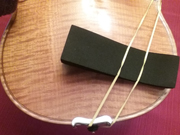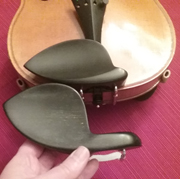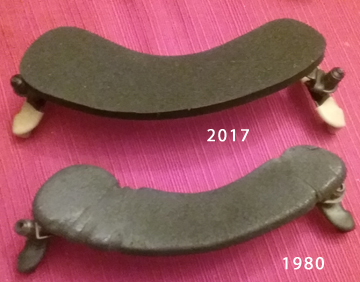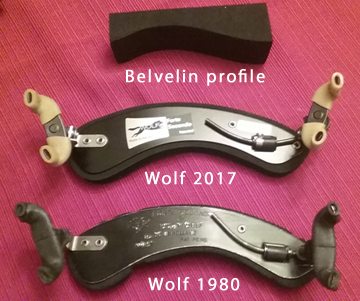 In violin-ese, your “setup” is how you match your equipment to your physique. Your setup can be good, bad or mediocre. Setup includes the accessories attached to the violin so that you can hold it, and also your playing mechanics like where it sits on your shoulder, how you hold your bow, etc. Since every body is different, the same setup will not work for every violinist.
In violin-ese, your “setup” is how you match your equipment to your physique. Your setup can be good, bad or mediocre. Setup includes the accessories attached to the violin so that you can hold it, and also your playing mechanics like where it sits on your shoulder, how you hold your bow, etc. Since every body is different, the same setup will not work for every violinist.
I’ve been experimenting with different types of shoulder rests for several years now, trying to find the perfect design and placement to give me a secure hold so I can play with accuracy and comfort. However, since I’m built slightly like a T-Rex (big head, thick neck, short arms), the popular combination of a Guarneri chinrest with a Kun shoulder rest has not worked for me. I cycled through virtually every type of shoulder rest on the market to find one that would work. (If you’re interested in my reviews of them, scroll to the bottom of this article.)
 I thought I had settled on the small, firm Belvelin foam shoulder rest. Since it’s not a fixed-in-place bar with feet, it gave me the ability to move the violin to the left (to play high on the G string) or to the right (to reach the tip of the bow). It was also very comfortable for average periods of playing time, it didn’t fall off like the Kun, or threaten to ding the varnish on the back of my violin like the Bonmusica. But I found that I was in a lot of pain after a two-hour performance. Why?? Because I was only addressing half of my setup problem.
I thought I had settled on the small, firm Belvelin foam shoulder rest. Since it’s not a fixed-in-place bar with feet, it gave me the ability to move the violin to the left (to play high on the G string) or to the right (to reach the tip of the bow). It was also very comfortable for average periods of playing time, it didn’t fall off like the Kun, or threaten to ding the varnish on the back of my violin like the Bonmusica. But I found that I was in a lot of pain after a two-hour performance. Why?? Because I was only addressing half of my setup problem.
I found this very helpful research project on adapting chinrests and shoulder rests to different violinists’ shapes and sizes. Aha! I definitely needed to work on the topside of my violin and see if my chinrest should be changed out.
According to the research, even though the Guarneri-style chinrest is currently the most popular, it fits a surprisingly small percentage of “average” musicians. The Guarneri rest came with my shop-adjusted violin, and is clearly large enough for a 6′ tall man with a heavy protruding jaw. I am a 5’1″ female with a short neck and no jawline to speak of. But, which model to choose? And where could I try out several models before buying?
Of course, the answer was my nearest full-service violin shop. Though they didn’t have a huge number of different models to choose from (I tried a Teka, a Berber and a Dresden), I lucked out because one of them is a perfect fit: the Priska.
 Check out the difference in the sizes of the chinrests: The Guarneri (in my hand) and the Priska (on my violin). See how the Priska chinrest accommodates the player’s chin/jaw closer to the middle, over the tailpiece, which is ideal for a player with shorter arms like me. I’m also noticing that my violin feels lighter now: I lost several ounces of solid ebony in the trade.
Check out the difference in the sizes of the chinrests: The Guarneri (in my hand) and the Priska (on my violin). See how the Priska chinrest accommodates the player’s chin/jaw closer to the middle, over the tailpiece, which is ideal for a player with shorter arms like me. I’m also noticing that my violin feels lighter now: I lost several ounces of solid ebony in the trade.

 And while I was in the shop, I picked up a new shoulder rest too. It’s exactly the same model (Wolf Forte Secondo) as the one I used to use almost 40 years ago (but much less worn!), and it turns out that it’s a great match for this new chinrest with my playing style and body type. It can be adjusted to a minimum height, similar to my Belvelin foam rest, but with the sturdy support I was lacking. I think I can now tackle a 2-hour performance with much less pain and more security playing up high on the fingerboard.
And while I was in the shop, I picked up a new shoulder rest too. It’s exactly the same model (Wolf Forte Secondo) as the one I used to use almost 40 years ago (but much less worn!), and it turns out that it’s a great match for this new chinrest with my playing style and body type. It can be adjusted to a minimum height, similar to my Belvelin foam rest, but with the sturdy support I was lacking. I think I can now tackle a 2-hour performance with much less pain and more security playing up high on the fingerboard.
Okay, nutshell reviews of several shoulder rest models:
Kun: Pretty comfortable and adjustable, standard bar-type, but FALLS OFF ALL THE TIME! I’m so over this one.
Bonmusica: I switched to this when I first started getting an achy back at long rehearsals. It can be curved to fit over your shoulder, practically holding the violin up all by itself. But once in place, it has a tendency to immobilize your shoulder joint, leading to tension and inflexibility. And, the feet can slip off the violin while playing, crunching the shoulder rest into the back of your instrument. With all that exposed metal, you’re asking for a nick in your varnish at the least. I retired this when I bought a new violin.
Everest: A good basic shoulder rest, but not very adjustable. I recommend it for students instead of the Kun (see above).
Purple Foam: Don’t know who makes these, but they are carried by music stores in different sizes. I started using this when I went to Mimi Zweig’s teachers’ workshop, since she is pro-sponge and anti-footed-bar (which she calls a “Brooklyn Bridge”). But I wanted something a little classier looking (black, no rubber band needed), so I tried:
AcoustaGrip: Violin-shaped (!) foam pad that is supposed to cling to the back of the violin. This didn’t hold on for very long and I ended up using a rubber band again. Then I shaved parts of it off because I thought it was covering too much of the back and possibly dampening my sound. Once I’d done that, I started looking for a firmer, narrower sponge and ended up with:
Belvelin: A good, comfortable shaped-foam design. A small one is all you need. Provides a flexible hold that moves with you. But, not so comfortable for playing long periods without a break.
Artino Magic Pad: When I was experimenting with the lowest possible shoulder rest profile, I tried one. It was way too low. Might work for a child but wasn’t doing it for me. The only way I could have kept using it was if I had a higher-than-normal custom chinrest made, similar to what they did in the research cited above.
Wolf Forte Secondo: Tried and true, the design hasn’t changed in over 40 years. Highly adjustable, can be bent, conforms to your shoulder profile. Here is an enthusiastic user’s video review. If it ain’t broke, don’t fix it!
